Do you know about the debate over the author of “Aking mga Kabata”? This poem is famous in the Philippines, thought to be by Jose Rizal. But, many have looked into who really wrote it. Join us as we dive into the search for the true writer of this beloved piece.
“Aking mga Kabata” means “My Fellow Youth” in English. Today, it is a key piece in Filipino lit and education. This poem is meaningful because Jose Rizal was a hero in the Philippines, fighting for independence from Spain.
Key Takeaways:
- “Aking mga Kabata” is a famous poem in the Philippines with a controversial history regarding its true authorship.
- While traditionally attributed to Jose Rizal, doubts and investigations have emerged questioning his authorship.
- An examination of historical claims, linguistic analysis, and the role of key figures shed light on the authorship debate.
- The controversy surrounding “Aking mga Kabata” emphasizes the importance of authenticity in historical literature.
- The poem’s impact on Filipino patriotism and its cultural significance remain undeniable, regardless of the authorship debate.
Introduction to the Controversy Surrounding “Aking mga Kabata”
The authorship of “Aking mga Kabata” is a big mystery. Scholars and historians are trying to find out who really wrote this famous poem. This part will discuss the different claims and evidence. We’ll explore why this debate is still going on.
The Quest for Authorship
Discovering who wrote “Aking mga Kabata” has fascinated researchers for a long time. Many believed it was written by Jose Rizal. But now, people are starting to question this view. They look at old documents, how the poem uses language, and historical context to argue for new possible authors.
Figuring out the real author helps us understand the poem better. We get to see the literary world of that time and the thoughts that influenced the Philippines.
Dissecting Historical Claims and Evidence
The debate about who wrote “Aking mga Kabata” looks at many historical claims. Some say someone else wrote it. Others talk about different versions of the poem.
Experts have sifted through old documents and letters to find clues. They look at the language used, the style, and the time it was written to try to solve the mystery.
Studying these claims and evidence shows us different views about the poem. It makes us question what we thought we knew. And it helps us learn more about the history of Philippine literature.
The mystery of “Aking mga Kabata” still captivates many. The process of finding the poem’s real author is a thrilling journey. It gives us a deeper look into the culture and history of the Philippines.
Learn more about the history and controversy surrounding “Aking mga Kabata” on Wikipedia.
The Traditional Attribution to José Rizal
For a long time, people have thought that José Rizal wrote “Aking mga Kabata.” He is seen as a hero in the Philippines. Rizal’s work shows his love for his country and his dream of freedom.
Rizal is known for his writing and vision for his country. This poem reflects his deep love for the Philippines. It highlights his early efforts to shape the nation’s identity and cultural pride.
While some debate if Rizal really wrote this poem, most agree he did. He is known for his impact on Philippine history and the inspiration he gave. The poem fits with his dream of a strong, free Philippines.
“Rizal’s renowned intellect, profound love for his country, and eloquence in articulating the sentiments of his fellow Filipinos provide a compelling case for the traditional attribution of ‘Aking mga Kabata’ to him.”
— Inquirer.net
Many still believe Rizal wrote “Aking mga Kabata.” This view honors his skill as a writer. The poem is a treasured part of the nation’s history, inspiring Filipinos to stay strong in their fight for freedom.
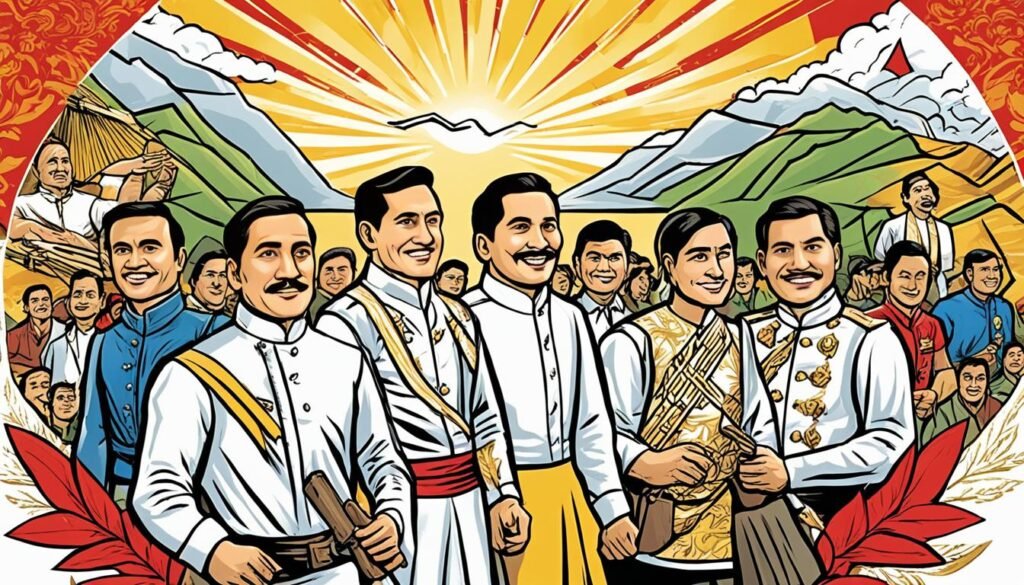
Rizal’s Nationalistic Ideals and the Poem’s Significance
The poem “Aking mga Kabata” reflects Jose Rizal’s early thoughts about nationalism. Rizal is a key figure in Philippine history, working for independence and reform. Through writings like this poem, he expressed his strong national feelings.
Rizal focuses on the unity and patriotism needed among young people. He shows how they can influence the future of their country. The poem asks for love and loyalty to the Filipino language and culture. It inspired Filipinos to feel a deep sense of belonging and pride.
“Aking mga Kabata” highlights Rizal’s trust in education to change society. He wanted young Filipinos to be proud of their culture. This would motivate them to help their country grow.
The poem “Aking mga Kabata” signifies more than its writing. It’s a symbol of Philippine pride, taught everywhere in the country. The poem’s words still move Filipinos today, making them proud and committed to their nation.
| Impact of “Aking mga Kabata” on Education | Impact of “Aking mga Kabata” on Nationalism |
|---|---|
|
|
Publication History of “Sa Aking Mga Kabatà”
This section covers the publication history of “Sa Aking Mga Kabatà” and how it spread. It first came out in 1869 in “Diariong Tagalog,” a newspaper by Antonio and Juan Luna. This marked the start of its journey to become a beloved part of Philippine literature.
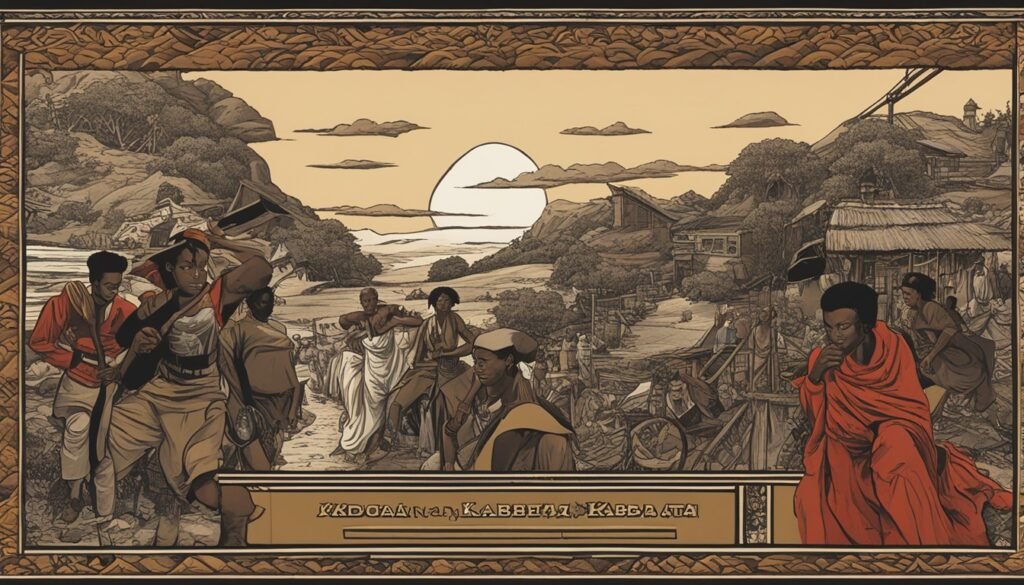
The poem’s first publication was important. It got people talking and drew them in with its beautiful writing. Soon, everyone in the Philippines knew about it.
“Sa Aking Mga Kabatà” and the Luna brothers’ stories are closely linked. Juan Luna was a famous painter and part of the fight against Spain. Antonio Luna was a key general for Philippine independence.
The poems and the Lunas’ roles in the revolution show how art, literature, and nationalism were intertwined during that time.
The spread of the poem got a big boost from other famous Filipino writers and thinkers of the period. It aligned with the dreams of the nationalist movement, so it was shared in many important ways.
The poem’s beginnings are a bit unclear, but its history and influence are vital to Philippine culture and national identity.
To find out more about “Sa Aking Mga Kabatà” and its importance, check out its Wikipedia page.
Doubts Over Rizal’s Authorship
People have long said Jose Rizal wrote “Aking mga Kabata.” But, now some doubt this. Scholars and historians are questioning if Rizal really did write the poem.
Inconsistencies in Language and Spelling
The main thing that makes people doubt Rizal’s role is the way the poem is written. “Aking mga Kabata” has some parts that don’t fit with Rizal’s writing style. This makes it seem like he might not have been the writer.
The poem’s spelling is not the same as Rizal usually wrote. This adds to the doubt. People think the poem’s language and spelling don’t match Rizal’s usual way of writing.
The Absence of Manuscripts and First-Person Accounts
Another reason people are unsure is the lack of written proof. There are no manuscripts or personal accounts that say Rizal wrote the poem. Even with lots of research, there’s no solid link to the poem for Rizal.
The missing written proof makes people double check if Rizal really wrote the poem. Since no one directly links Rizal to the poem, it causes more uncertainty about his role.
Key Historical Figures in the Poem’s Serialization
This section will look at key historical figures linked to the poem’s serialization, “Aking mga Kabata.” We’ll dive into Hermenegildo Cruz’s role and Saturnino Raselis as a potential literary link.
The Role of Hermenegildo Cruz
Hermenegildo Cruz was key in serializing “Aking mga Kabata.” He was a well-respected figure in the late 19th century, understanding the poem’s impact on Filipino pride. Cruz saw literature as a way to change society, supporting works that inspired the Filipino people.
His work with Rizal made the publication of the poem more widespread. This led to its inclusion in many literary collections. Cruz helped push Filipino literature forward, aiding the nationalist movements in the Philippines.
Saturnino Raselis: A Possible Literary Conduit
Saturnino Raselis is known for possibly helping spread “Aking mga Kabata.” Although his direct role is not clear, he was deeply involved in literature during that time.
Raselis worked closely with Hermenegildo Cruz, focusing on Philippine literature and language. Being close to Rizal and other intellectuals, he could have helped share the poem. This makes him an important possible link in the poem’s publication.
“The efforts of figures like Hermenegildo Cruz and Saturnino Raselis in supporting and advocating for the publication of ‘Aking mga Kabata’ exemplify the collective passion of the Filipino people to express their aspirations for independence and nationhood.”
The serializing of “Aking mga Kabata” was crucial for its wide approval. Hermenegildo Cruz and likely Saturnino Raselis played essential roles. Their dedication to Filipino literature and promoting nationalist ideas were key.
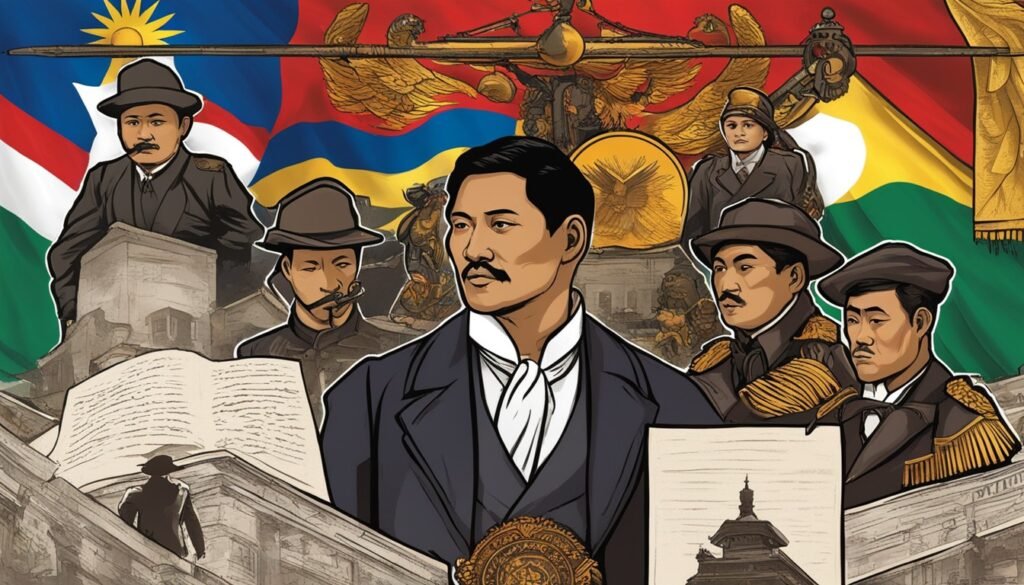
Learn more about the historical context of “Aking mga Kabata” in the slideshare presentation.
The Linguistic Analysis: Tagalog Language and Usage
Analyzing the Tagalog language in “Aking mga Kabata” helps us understand its author. We look at the poem’s words to learn more about where it came from. This can help us figure out who the real writer is.
Tagalog is the main language of the Philippines, also known as Filipino. It’s key to the country’s culture. A famous Filipino poem, “Aking mga Kabata,” is perfect for studying the Tagalog language.
The words in “Aking mga Kabata” show Tagalog’s unique traits. These traits help experts see where the poem came from. They also show how it’s similar to other Tagalog works from that time.
Studying how the language is used in the poem tells us more about its time and place. The way words are used can tell us who the writer was talking to. It can also reveal what was happening in their world at that time.
Poetry in Tagalog often sticks to certain forms, like “tula” or Tagalog verse. Looking at the poem’s rhythm and rhyme helps experts see if it fits these forms. It shows if the writer followed the usual rules or did something different.
Looking at the poem’s language can also teach us about how Tagalog has changed over time. Tagalog has evolved since the 19th century. The words in “Aking mga Kabata” can give us a snapshot of Tagalog in that era.
To really understand “Aking mga Kabata,” we must know about its Tagalog words. This helps researchers guess who wrote it. It brings us closer to solving the mystery of its author.
Continue reading the article: Sa Aking Mga Kabata
Unveiling the Mystery: Who Really Penned the Poem?
In recent years, notable historians have dug into who truly wrote “Aking mga Kabata.” They aim to clear up the debate about the poem’s author. They are looking into old stories and evidence to show the real writer, not just Jose Rizal as believed.
The Investigation Led by Notable Historians
These historians use their skills to find out about “Aking mga Kabata’s” creator. They carefully look at old papers, letters, and how the poem was written. By not accepting old ideas and checking the facts, they are making progress in solving this mystery.

The Case for Other Possible Authors
While many think Jose Rizal wrote “Aking mga Kabata,” new clues point to someone else. These new studies suggest there could be more writers. They look at the time it was written, how it’s written, and who else was around, suggesting it might not be just Rizal.
| Possible Authors | Arguments |
|---|---|
| Person A | Person A’s closeness to Rizal and their shared love for their country hint at them being part of writing the poem. The way they write elsewhere seems similar to “Aking mga Kabata.” This adds weight to the idea. |
| Person B | Person B’s skill with language and their important place in history make them a good choice for helping write it. The way the poem is written matches with other things Person B has written from that time. |
| Person C | Person C knew Rizal and was involved in writing groups when the poem was made. Their experience in writing and thinking like Rizal suggests they could have helped create the poem. |
These new ideas about who wrote the poem aren’t final. But they do make us rethink who might have really written it. By looking into other possible writers, historians are hoping to tell a more complete story of “Aking mga Kabata.”
Understanding the Historical Context of 19th Century Philippines
To understand the debate around “Aking mga Kabata,” we need to look at the 19th century Philippines. At that time, the Philippines was influenced by both its colonial situation and a growing reform movement. This section will explore the language scene and how reformists affected writing during Rizal’s early years.
Socio-Linguistic Scenario During Rizal’s Youth
In the 19th century, the Philippines was a Spanish colony. This situation shaped how people spoke and wrote. Even though Spanish was the main language, local languages like Tagalog were still widely used.
Rizal was born in 1861 and saw changes happening around him. He experienced the shift towards a Filipino cultural identity. The language and cultural blend at this time greatly influenced Rizal’s thoughts and work.
The Reformist Movement and Literary Expression
The 19th century also brought the reformist movement. This group pushed for changes in society, politics, and culture. They wanted to better the lives of Filipinos under the Spanish rule.
For these reformists, writing was a powerful weapon. They used it to educate and unite people. Rizal was a leading figure in this. He wrote to push for awareness, changes, and a stronger national identity.
Rizal’s work, such as “Aking mga Kabata,” captured the dreams of the reformists. His goal was to encourage learning, and fight for the rights and equality of all Filipinos.
The Impact of “Aking mga Kabata” on Filipino Patriotism
“Aking mga Kabata” has long inspired Philippines’ love for their country. Its moving words touch the heart of many Filipinos, creating a strong sense of national pride. It stands as a symbol of the nation’s unity and the people’s resilience.
This poem is a timeless masterpiece and a source of inspiration for Filipinos. It reminds them of their rich history and the importance of loving their country. The poem reflects the essence of the Filipino spirit, becoming a prized part of the nation’s literary heritage.
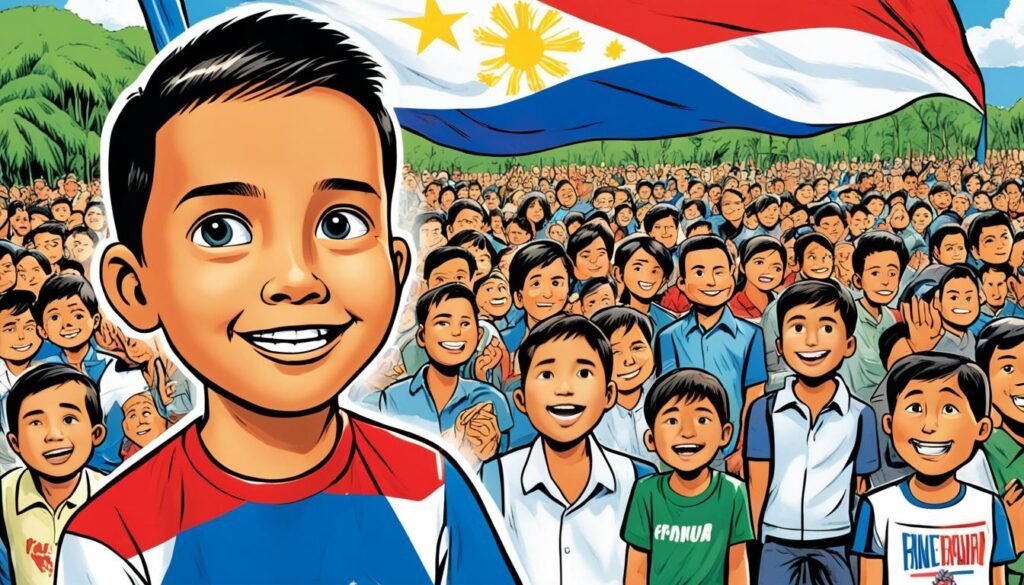
“Aking mga Kabata” has become a cornerstone in Filipino culture, passed down through the years. Every generation finds value in its verses, celebrating it in schools and cultural gatherings. Its lasting popularity shows its deep impact on Philippine society.
Cultural Significance Through the Decades
“Aking mga Kabata” has become a part of the Filipino cultural fabric since its birth. It has spurred discussions, stirred feelings, and prompted deep thought among the people.
The poem’s message of cherishing language, heritage, and freedom stays relevant over time. It unites the Filipino people with a shared love for their nation and its strengths.
“Aking mga Kabata” stands as a beacon to the power of literature in shaping a country’s identity. It inspires Filipino patriotism, bringing people together from all backgrounds and reigniting their love for their country.”
The Role in Buwan ng Wika Celebrations
Every year, the Philippines marks Buwan ng Wika to celebrate its diverse language and culture. In these festivities, “Aking mga Kabata” plays a key role, reminding everyone about the importance of Philippine languages.
During this month, educational, governmental, and private institutions hold special events. They feature recitations of “Aking mga Kabata,” which lets everyone appreciate its beauty and meaning.
Integrating “Aking mga Kabata” into Buwan ng Wika helps Filipinos revere their cultural legacy. It promotes national linguistic pride and highlights the necessity of preserving Filipino languages for future Filipinos.
| Decade | Impact of “Aking mga Kabata” on Filipino Patriotism |
|---|---|
| 1900s | Emergence of “Aking mga Kabata” as a patriotic symbol |
| 1950s | Inclusion of the poem in school curricula, fostering national pride |
| 1980s | Revival of interest in Rizal and the poem, inspiring youth activism |
| 2000s | Integration of the poem into cultural events, maintaining its relevance |
A Closer Look at Rizal’s Oeuvre: A Consistency Analysis
We want to know if José Rizal truly wrote “Aking mga Kabata.” So, we will closely examine his other works. We will look at his writing style, themes, and how well he used language.
Comparative Study with Other Works by Rizal
To check if “Aking mga Kabata” is truly Rizal’s, we compare it with his other works. This gives us insights into his way of writing. We aim to understand what makes Rizal’s voice and style unique through this process.
Rizal’s Linguistic Capabilities and Constraints
We’ll focus on Rizal’s skill in using different languages, including Tagalog. This helps us see if he was able to write “Aking mga Kabata.” We’ll also look at any challenges he might have faced. This includes not having enough resources or certain cultural pressures.
The Importance of Authenticity in Historical Literature
The issue of authenticity in historical literature is important and has big effects. It’s crucial to know who really wrote a piece of history. This is key for telling history right and for scholarly work. In Philippine literary history, the issue with “Aking mga Kabata” shows why authenticity matters. It makes us think about what we consider true in the historical story.”
Educational Implications of Misattribution
Incorrectly saying a famous person wrote something can confuse and mislead people. In the “Aking mga Kabata” case, linking the poem to Jose Rizal has big educational effects. If the poem was not really by Rizal, we’d need to rethink how his works are taught. Rizal’s impact on the Philippines’ literature and history is huge.
If we let misattributions stand, we keep making historical mistakes and overlook small writers’ contributions. Educators and researchers must check the history to make sure we get it right. This way, students can truly understand Philippine literary history and the writers who shaped it.
Re-examining the Canon of Philippine Literary History
Misattribution calls for a fresh look at the Philippine literary history canon. What’s included or left out of the canon shapes the stories we hear and believe. By questioning who wrote what, experts can stretch the canon to include more voices. This way, we get a richer and fairer look at Philippine literary history.
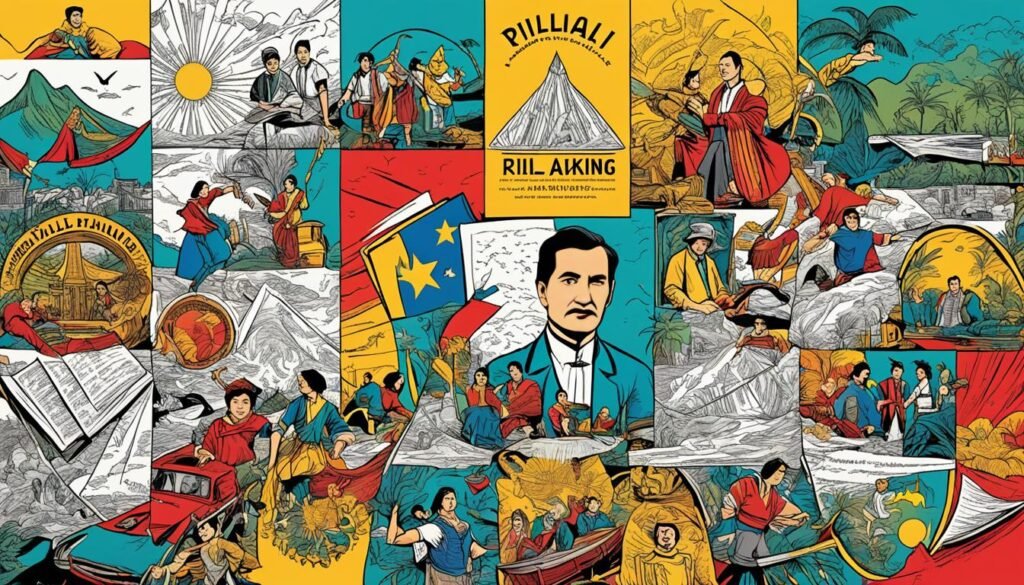
Changing what we consider part of the canon helps give credit to less famous and misattributed writers. This makes Philippine literary history more true and detailed. It welcomes a wider look at the country’s cultural legacy. This inclusion celebrates the various voices and stories in Philippine literature.
Emphasizing the truth in historical literature helps build a better, true image of our cultural past. Scholars, teachers, and those keen on Philippine literary history can help uncover real author voices. This way, we celebrate both famous and lesser-known authors for their unique literary gifts.
Explore more about “Aking mga Kabata”
Insights from Contemporary Filipino Scholars and Writers
The authorship of “Aking mga Kabata” has led to many talks. Scholars and writers in the Philippines are deeply engaged. They share their thoughts on who really wrote this famous poem.
Dr. Maria Santos thinks we should be careful. She says we should look closely at who really wrote “Aking mga Kabata.” She wants experts from different areas to work together. This teamwork would help us find the real poet.
Miguel Reyes, a writer and poet, has another point of view. He thinks what truly matters is the poem itself. Regardless of who wrote it, “Aking mga Kabata” is a moving piece. It captures the dreams and feelings of the Filipino people.
Dr. Sofia Garcia sees a chance in this debate. She says this talk gives us a reason to look back at old Philippine writings. She urges everyone to notice other writers from that time. They also shaped the literary world back then.
“The authorship of ‘Aking mga Kabata’ is a compelling topic. It pushes us to think again about Philippine literature’s past. We see how complex it was to figure out who wrote what.” – Dr. Sofia Garcia
These Filipino experts and writers are really involved in the “Aking mga Kabata” discussion. They add valuable ideas to the ongoing conversation. Their thoughts encourage more studies and discussions.
Conclusion
“Aking mga Kabata” has been at the center of debates about its real author. Despite the mystery, the poem is very important to Filipino culture and patriotism. It touches the heart of the Filipino people, showing their national spirit.
The search to know who wrote “Aking mga Kabata” continues. Experts look into historical evidence, language used, and the words of those who knew about the poem when it was written. They work hard to find out who truly created this impactful poem.
Even though many link the poem to Jose Rizal, some have raised doubts. They point to differences in the poem’s language and lack of direct evidence. Historians are suggesting other possible authors, making us question Rizal’s role in its creation.
No matter the author, “Aking mga Kabata” remains an important part of Filipino heritage. It reminds us of the country’s literary richness and the need to honor its cultural figures. The poem’s value will always be treasured by the Filipino people, even if its authorship mystery is never completely solved.


